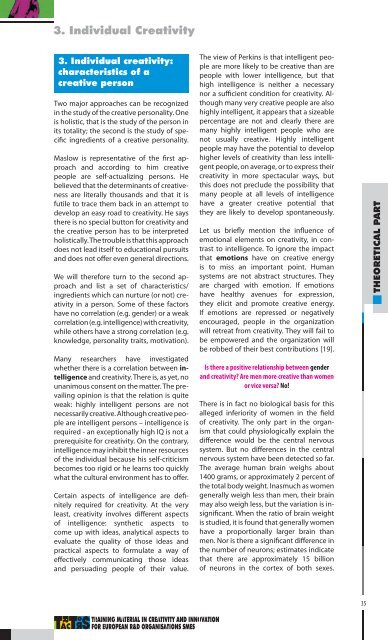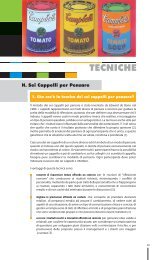Creativity Theory - TRaining MAterial in Creativity and InnovaTion ...
Creativity Theory - TRaining MAterial in Creativity and InnovaTion ...
Creativity Theory - TRaining MAterial in Creativity and InnovaTion ...
You also want an ePaper? Increase the reach of your titles
YUMPU automatically turns print PDFs into web optimized ePapers that Google loves.
3. Individual <strong>Creativity</strong><br />
3. Individual creativity:<br />
characteristics of a<br />
creative person<br />
Two major approaches can be recognized<br />
<strong>in</strong> the study of the creative personality. One<br />
is holistic, that is the study of the person <strong>in</strong><br />
its totality; the second is the study of specific<br />
<strong>in</strong>gredients of a creative personality.<br />
Maslow is representative of the first approach<br />
<strong>and</strong> accord<strong>in</strong>g to him creative<br />
people are self-actualiz<strong>in</strong>g persons. He<br />
believed that the determ<strong>in</strong>ants of creativeness<br />
are literally thous<strong>and</strong>s <strong>and</strong> that it is<br />
futile to trace them back <strong>in</strong> an attempt to<br />
develop an easy road to creativity. He says<br />
there is no special button for creativity <strong>and</strong><br />
the creative person has to be <strong>in</strong>terpreted<br />
holistically. The trouble is that this approach<br />
does not lead itself to educational pursuits<br />
<strong>and</strong> does not offer even general directions.<br />
We will therefore turn to the second approach<br />
<strong>and</strong> list a set of characteristics/<br />
<strong>in</strong>gredients which can nurture (or not) creativity<br />
<strong>in</strong> a person. Some of these factors<br />
have no correlation (e.g. gender) or a weak<br />
correlation (e.g. <strong>in</strong>telligence) with creativity,<br />
while others have a strong correlation (e.g.<br />
knowledge, personality traits, motivation).<br />
Many researchers have <strong>in</strong>vestigated<br />
whether there is a correlation between <strong>in</strong>telligence<br />
<strong>and</strong> creativity. There is, as yet, no<br />
unanimous consent on the matter. The prevail<strong>in</strong>g<br />
op<strong>in</strong>ion is that the relation is quite<br />
weak: highly <strong>in</strong>telligent persons are not<br />
necessarily creative. Although creative people<br />
are <strong>in</strong>telligent persons – <strong>in</strong>telligence is<br />
required - an exceptionally high IQ is not a<br />
prerequisite for creativity. On the contrary,<br />
<strong>in</strong>telligence may <strong>in</strong>hibit the <strong>in</strong>ner resources<br />
of the <strong>in</strong>dividual because his self-criticism<br />
becomes too rigid or he learns too quickly<br />
what the cultural environment has to offer.<br />
Certa<strong>in</strong> aspects of <strong>in</strong>telligence are def<strong>in</strong>itely<br />
required for creativity. At the very<br />
least, creativity <strong>in</strong>volves different aspects<br />
of <strong>in</strong>telligence: synthetic aspects to<br />
come up with ideas, analytical aspects to<br />
evaluate the quality of those ideas <strong>and</strong><br />
practical aspects to formulate a way of<br />
effectively communicat<strong>in</strong>g those ideas<br />
<strong>and</strong> persuad<strong>in</strong>g people of their value.<br />
The view of Perk<strong>in</strong>s is that <strong>in</strong>telligent people<br />
are more likely to be creative than are<br />
people with lower <strong>in</strong>telligence, but that<br />
high <strong>in</strong>telligence is neither a necessary<br />
nor a sufficient condition for creativity. Although<br />
many very creative people are also<br />
highly <strong>in</strong>telligent, it appears that a sizeable<br />
percentage are not <strong>and</strong> clearly there are<br />
many highly <strong>in</strong>telligent people who are<br />
not usually creative. Highly <strong>in</strong>telligent<br />
people may have the potential to develop<br />
higher levels of creativity than less <strong>in</strong>telligent<br />
people, on average, or to express their<br />
creativity <strong>in</strong> more spectacular ways, but<br />
this does not preclude the possibility that<br />
many people at all levels of <strong>in</strong>telligence<br />
have a greater creative potential that<br />
they are likely to develop spontaneously.<br />
Let us briefly mention the <strong>in</strong>fluence of<br />
emotional elements on creativity, <strong>in</strong> contrast<br />
to <strong>in</strong>telligence. To ignore the impact<br />
that emotions have on creative energy<br />
is to miss an important po<strong>in</strong>t. Human<br />
systems are not abstract structures. They<br />
are charged with emotion. If emotions<br />
have healthy avenues for expression,<br />
they elicit <strong>and</strong> promote creative energy.<br />
If emotions are repressed or negatively<br />
encouraged, people <strong>in</strong> the organization<br />
will retreat from creativity. They will fail to<br />
be empowered <strong>and</strong> the organization will<br />
be robbed of their best contributions [19].<br />
Is there a positive relationship between gender<br />
<strong>and</strong> creativity? Are men more creative than women<br />
or vice versa? No!<br />
There is <strong>in</strong> fact no biological basis for this<br />
alleged <strong>in</strong>feriority of women <strong>in</strong> the field<br />
of creativity. The only part <strong>in</strong> the organism<br />
that could physiologically expla<strong>in</strong> the<br />
difference would be the central nervous<br />
system. But no differences <strong>in</strong> the central<br />
nervous system have been detected so far.<br />
The average human bra<strong>in</strong> weighs about<br />
1400 grams, or approximately 2 percent of<br />
the total body weight. Inasmuch as women<br />
generally weigh less than men, their bra<strong>in</strong><br />
may also weigh less, but the variation is <strong>in</strong>significant.<br />
When the ratio of bra<strong>in</strong> weight<br />
is studied, it is found that generally women<br />
have a proportionally larger bra<strong>in</strong> than<br />
men. Nor is there a significant difference <strong>in</strong><br />
the number of neurons; estimates <strong>in</strong>dicate<br />
that there are approximately 15 billion<br />
of neurons <strong>in</strong> the cortex of both sexes.<br />
35<br />
THEORETICAL PART



